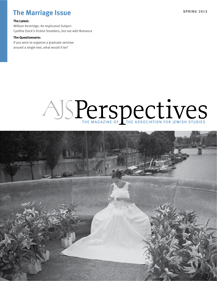Dear Colleagues,
In 1989, when AJS was twenty years old and had been growing in size and scope, its leadership decided that the time had come to institute a new means of planning the annual conference. Instead of having all paper and panel submissions come to a single address, AJS would divide the field into sections. The head of each division would collect submissions for its respective subfield and submit recommendations to the central program committee—in effect, the procedure AJS currently uses. Legend has it that the first draft of conference divisions was made by the heads of AJS one evening while sitting at the bar of the Copley Hotel in Boston (where AJS then convened every year), jotting down their rubric on a cocktail napkin.
Like most legends, the facticity of this one is less important than the understandings that inhere within it. This bit of AJS lore infers that the task of dividing up Jewish Studies into subfields was straightforward; the divisions were readily apparent and did not require extensive reflection or debate. These divisions are not all of a kind; they are variously defined by discipline, language, geography, canonical text, or historical period. Though the divisions AJS uses to organize its conference have been tweaked over the years, the original rubric drafted in 1990 remains at the foundation of this system.
The changes made in these divisions over time have come about largely in response to what members propose to present at the annual conference. For example, this past December, the Program Committee agreed to dissolve the division on Gender, following the recommendation of this division's chair, who argued that proposals of papers and sessions dealing with issues of gender and sexuality now are regularly sent to so many other divisions of the conference that relatively few submissions on the topic come to the Gender division. The study of gender and sexuality in Jewish Studies has, in effect, been mainstreamed. Hence, the need for a separate division, which had been created in the early 1990s to bring much-needed attention to this work in Jewish Studies, now seems a less effective way of addressing the field's expansive engagement with gender and sexuality. (Note that the conference still welcomes submissions of interdisciplinary presentations on this topic; for details, see the Call for Papers on the AJS website.) This issue, as well as other questions of how to modify the conference structure, received much debate at the December meeting of the Program Committee, and its members continue to consider how the conference can better reflect the shape of the field. As Jewish Studies continues to change, the notion that its structure is self-evident has given way to more complex, ongoing probing of how the field is developing.
This issue warrants attention in other venues as well. Delineating the scope and organization of Jewish Studies is likely realized most extensively, if implicitly, in the rosters of courses offered by the undergraduate Jewish Studies programs in which many of us teach. I recently thought about how the dynamics of the field are reflected in this setting when I came across an intriguing artifact while doing research at the Magnes Collection of Jewish Art and Life in Berkeley: a brochure listing courses offered by the Department of Jewish Studies of the City College of New York in Spring 1974. Though by then CCNY no longer taught a preponderance of Jewish students (they had numbered some 80 percent of enrollees during the interwar years), it had established a substantial Jewish Studies department, something few institutions of American higher education had at the time. Indeed, the brochure describes this as a new program, "on the cutting edge of history."
That spring, CCNY offered twenty-one lecture courses in Jewish Studies, some of them cross-listed with other departments, as well as language courses in Arabic, Hebrew, and Yiddish. The roster includes a survey of Jewish history, courses on Jewish thought, Bible, Talmud, medieval and modern Hebrew literature, Yiddish literature, Holocaust literature, Hasidism, Israeli society, American Jewish immigration, and the sociology of Jewish identity; among topics announced for the next semester are courses on Jewish women, mysticism, and Holocaust history.
This list looked very familiar to me; it is strikingly similar to a typical semester of Jewish Studies courses at Rutgers and seems to resemble the offerings of many other Jewish Studies programs in North American schools of higher education. There are, of course, some noteworthy differences: Other than sociology, CCNY offered no courses in the social sciences; there were no courses on Sephardi or Mizrahi Jewry or on Jewish art, music, theater, film, or other media—all topics addressed in courses Rutgers and other schools often offer. On the whole, however, the rubric of Jewish Studies seems more unchanged than not over the course of nearly forty years.
What does one make of this comparison? Is it a sign of the field's stability or of its stagnation? Does undergraduate teaching reflect the intellectual dynamics of Jewish Studies scholarship? Should it do so— and for that matter, can it, given the extent to which courses must fit into the requirements of schools and the rubrics of other departments? The larger trend of Jewish Studies, as reflected in AJS conferences of recent years, has been to expand the field's sense of the possible, integrating new methods and areas of inquiry into more established topics and approaches. As a consequence, the question of what Jewish Studies constitutes and how it is constituted figures with growing frequency in both individual scholars' work and in discussions among scholars. I believe firmly that this ongoing self-reflection is a strength of the field and should be encouraged both in AJS endeavors and beyond. The nimbleness of Jewish Studies is an advantage for established scholars and new students alike. How, then, can we extend this thoughtful intellectual agility to our teaching, especially at a time when the means and ends of higher education are being rethought?
Jeffrey Shandler
Rutgers University

